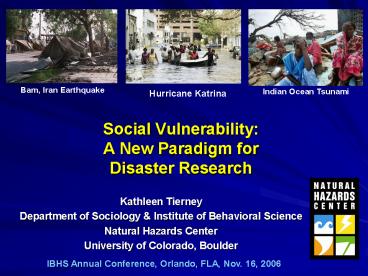Social Vulnerability: A New Paradigm for Disaster Research - PowerPoint PPT Presentation
1 / 20
Title:
Social Vulnerability: A New Paradigm for Disaster Research
Description:
New Ways of Understanding Disaster Vulnerability: Vulnerability Studies ... Disasters and Disaster Impacts are Socially Produced Not Caused by ... – PowerPoint PPT presentation
Number of Views:978
Avg rating:3.0/5.0
Title: Social Vulnerability: A New Paradigm for Disaster Research
1
Social VulnerabilityA New Paradigm
forDisaster Research
Bam, Iran Earthquake
Indian Ocean Tsunami
Hurricane Katrina
- Kathleen Tierney
- Department of Sociology Institute of Behavioral
Science - Natural Hazards Center
- University of Colorado, Boulder
IBHS Annual Conference, Orlando, FLA, Nov. 16,
2006
2
What This Talk Isnt About
- How Disaster Losses Are Skyrocketing Worldwide
- Hazard Insurance
- Economic Incentives for Disaster Loss Reduction
3
What This Talk Is About
- The Societal Dimensions of Vulnerability and Loss
- New Ways of Understanding Disaster Vulnerability
Vulnerability Studies - Vulnerability, Resilience, and Social Capital
4
Vulnerability StudiesA Multidisciplinary Field
- Physical Sciences, Engineering, Environmental
Science - Spatial Social Science/Geography/GIS
- Sociology
- Other Social Sciences (Anthropology, Political
Economy, Policy Studies, etc.)
5
Social Vulnerability Paradigm Key Assumptions
- Disasters and Disaster Impacts are Socially
ProducedNot Caused by Meteorological, Geological
Events - Vulnerability is Linked to Larger-Scale Societal
and Global Processes and Their Interaction With
Extreme Events, Which Act as Triggers - Vulnerability is also Linked to Social-Structural
Features of Communities and Societies, e.g.
Poverty Inequality, Access to Resources
6
Contributors to Vulnerability
- Hazardousness of Place, Environmental and
Ecological Context - Vulnerability of the Built Environment
- Socially Structured Population, Group, Community,
and Societal Characteristics
7
Ecological, Environmental Sources of
Vulnerability
- Loss, Depletion of Ecosystem Services (Barrier
Islands, Wetlands, Other Natural Protections) - JARring Actions (Jeopardizing Assets That Are
Remote) - Development Pressures
- Protective Works, Moral Hazard
8
The Built Environment 2003 Bam
Earthquake Vulnerability of Traditional Adobe
Construction
9
The Built Environment
Residential Damage Northridge Earthquake
Levee Breaks Hurricane Katrina
10
Social and PopulationVulnerability
- Who Has Access to Safe, Well-
- Built Residential and Commercial Property?
- Who Mitigates, Prepares, Can Undertake Protective
- Measures?
- Who Suffers Disproportionate Losses?
- Who is More Resilient, Able to Recover?
Indian Ocean Tsunami
Hurricane Katrina
11
Social Vulnerability Influenced By
- Income and Educational Levels
- Socially-Structured Access to Self-Protective
Options - Disability, Age
- Minority Group Status, Gender, Language Barriers
- Social Capital
12
Poverty And Vulnerability Hurricane Katrina
13
Other Examples
- 1995 Chicago Heat Wave Mortality, Social
Networks, and Neighborhood Characteristics - Indian Ocean Tsunami
- Mortality, Gender, and
- Recovery
14
Vulnerability vs. Resilience
- Social Resilience as the Capacity to Identify,
Exercise Self-Protective Choices - Access to Information
- Access to a Wide Array of Options
- Resilience and Social Capital
15
US National Research Council Report, Facing
Hazards and Disasters Understanding Human
Dimensions (2006)
- Argues for the Importance of Social Capital-Based
Strategies in Enabling Households, Social Groups,
Neighborhoods, Community Sectors to Reduce
Disaster Losses
16
Societal Dimensions of ResilienceThe Relevance
of Social Capital
- Social Capital (Bourdieu, Putnam--Bowling Alone)
- Assets, Advantages Linked to Social
PositionEspecially Positions in Social Networks - Assets Include Information, Social Support,
Social Solidarity, Civic Engagement, Political
Influence, Trust, Access to Monetary Resources,
Capacity for Collective Action
17
Social Capital Indicators
- Civic Associations, Community-Based Groups
Voluntary Organizations, Occupationally-Based
Organizations, Other Indicators of Civic
Engagement - Formal and Informal Social NetworksBoth Within
and Between Groups - Presence of Intermediary and Advocacy Groups
(e.g., for Elderly, Persons With Disabilities) - Capacity to Influence Community Decisions
- Ties that Extend Beyond Local Community, e.g.
With State and Federal Government, Industry
18
Social Capital and Disaster Resilience Examples
- Promotes Hazard and Disaster Information Sharing,
Dissemination - Provides Material Emotional Support
- Helps Identify Pre- and Post-Disaster Needs
- Links Victims With Resources
- Results in Institutional Trust, Not Suspicion
- Strengthens Group Influence
- Facilitates Extra-Community Collaborations
- Promotes Collective Action, Strengthens Ability
to Exert Political Pressure
19
Your Interest in Reducing Vulnerability and
Promoting Resilience
- Better-Informed Residents of At-Risk Communities
- --Knowledge of Mitigation Measures
- --Understanding of Other Protective Options
- for Life Safety and Property Protection
- Greater Self-Sufficiency During and After
Disasters - Engaged Citizenry, Informed Consumers
20
- Natural Hazards Center
- University of Colorado
- 482 UCB
- Boulder, CO 80309-0482
Phone (303) 492-6818 Web www.colorado.edu/hazar
ds































